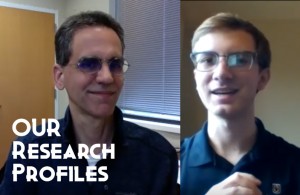 About Research Profiles
About Research Profiles
Interested in research but don’t know where to begin? Overwhelmed and turned away from research by the sheer volume of opportunities? Confused and intimidated by all the scientific jargon found in faculty research descriptions? You’re not alone, many students searching for a new lab have to search through hundreds of faculty pages and lengthy research descriptions before they find a lab they’re interested in that has space for an undergraduate. Luckily, the OUR Research Profiles is here to help. OUR Research Profiles hopes to help demystify research for undergraduates and help break down the initial barrier between interested undergraduates and potential labs.
Bond Life Sciences Center
Research at the Bond Life Sciences Center focuses on a variety of topics related to life sciences. Research areas range from the immune response of plants to the evolution of crop genomes to the animal and human health. Oriented toward basic research, some interesting current projects include looking at wastewater to predict Sars-Cov-2 outbreaks before they happen and a project examining RNAs as enzymes in the days before DNA and proteins were common funded by NASA. Also housed in the LSC are several research cores, which provide materials for labs conducting primary research and in-depth advice and knowledge for researchers in genetics, proteomics, metabolomics, and more.
To learn more about research at the LSC, we interviewed with its interim director, Dr. Walter Gassmann. Dr. Gassmann is very involved in research activities across the university, specializing in plant science, and has several undergraduates in his lab himself.
Dr. Gassmann says the most important quality in undergraduates looking for research is curiosity and courage to experiment. He says, “Even if you’re not quite sure, I think undergraduate research is really important because the best way to find out is this you want to sink a lot of time into is to try it out. I’ve had undergraduates who’ve decided after half a year that this is not for them, and that is totally fine.” He notes that while techniques can be taught, the drive to generate new knowledge cannot. Gassmann’s favorite thing about doing undergraduate research was asking questions no one yet knew the answer to, saying “I didn’t know what the outcome was I had to do it to find out what the answer is, that is the fun part.”
In the Gassmann lab, each lab member (including undergraduates) has their own project to focus on that fits into the larger goals of lab. Collaboration is key. The LSC has great collaboration between research groups as well. Dr. Gassmann says, “It can be all the way from very formal in that you have a joint grant to very informal that two lab members exchange protocols.” Congregation of life science research in one area makes the exchange of knowledge and developments between labs very easy.
Research takes place in many places in the LSC. Apart from the typical laboratory spaces, the LSC also includes greenhouses and animal facilities where research is conducted. Most labs at the LSC are happy to take on undergraduates, provided they have the space and a senior member of the lab with the time to mentor an undergraduate. Usually, about ten hours of work a week is a good goal for undergraduate research. In life science, it is often better to divide these ten hours between just a few large blocks of time as experiments may take several hours.
That’s it for the essential questions. Listen to the full podcast for more info on research at the Life Sciences Center, including specifics for research opportunities and Dr. Gassmann’s personal experiences in research from an undergraduate through his appointment to interim director of the LSC.
TO LISTEN TO THE FULL PODCAST CLICK HERE